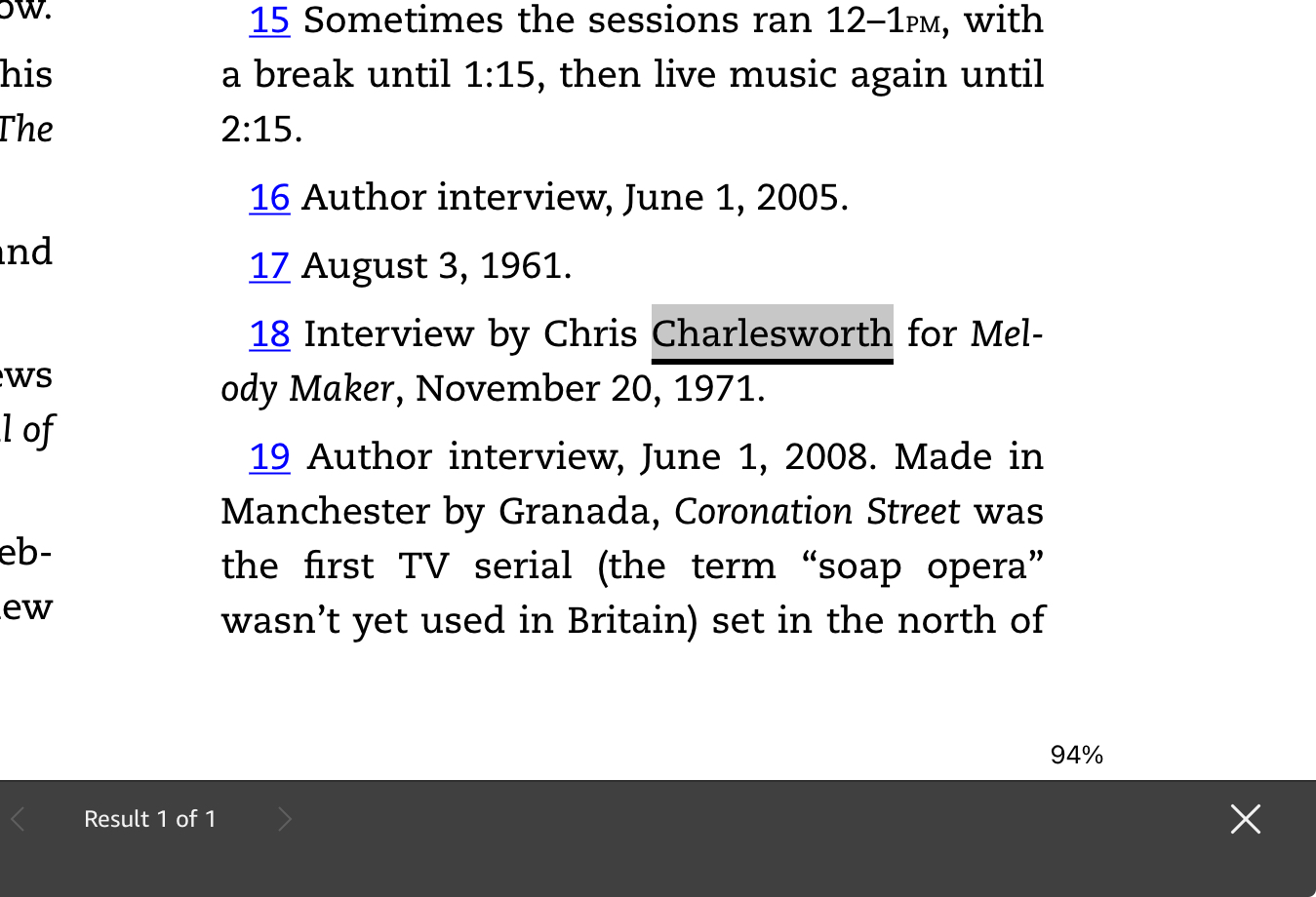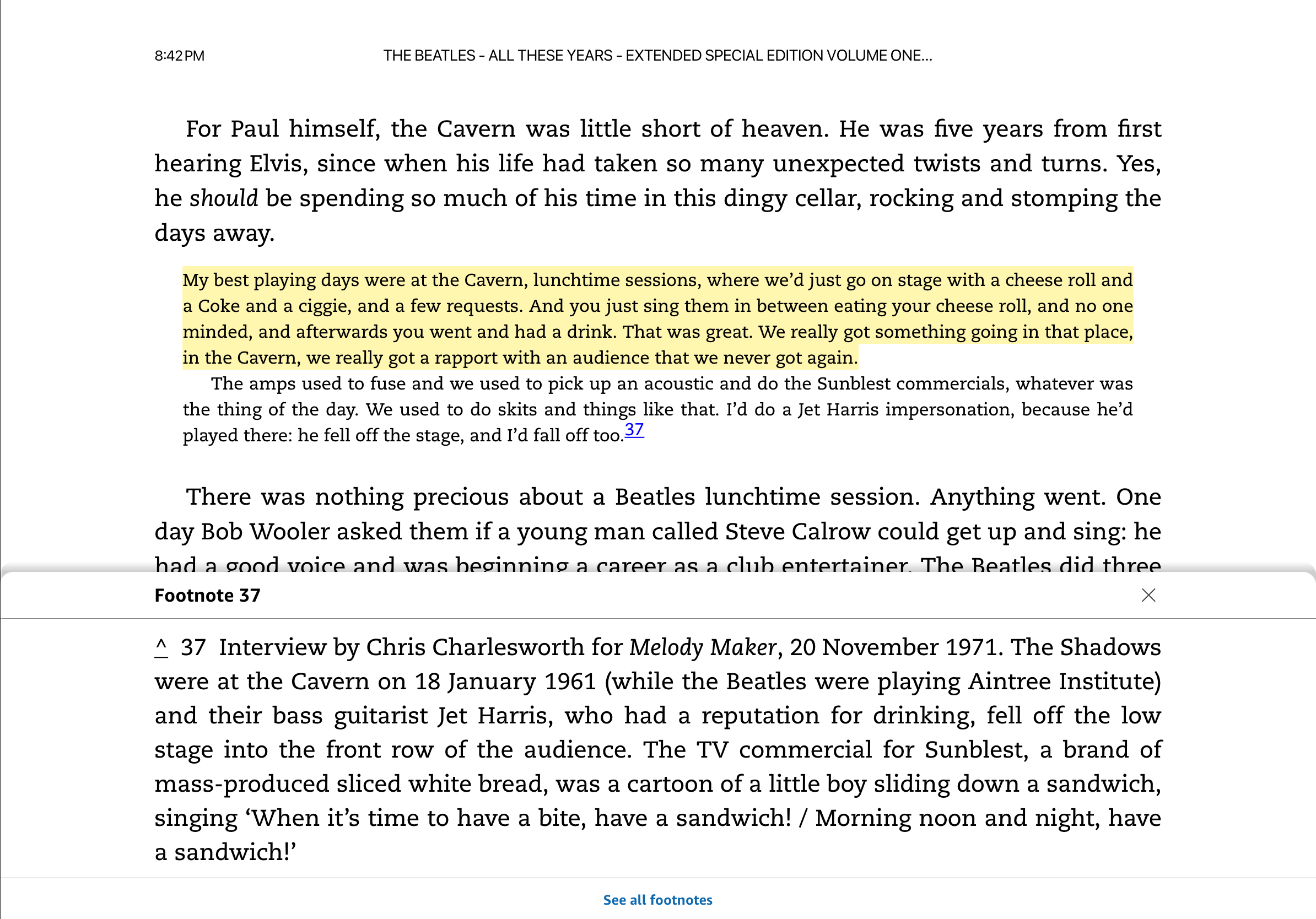Paul McCartney’s Cavern quote, sourced to Melody Maker in Tune In. (20-18)
This Cavern quote looks like either a Frankenquote or a fully mistaken citation instead of a fabrication. Mea culpa. I have learned my lesson about limbs and crawling out on them going forward, but despite my misclassification, it was based on an accurate reading of a rubbish citation.
Okay, this quote has been reproduced with slight variations in at least three different places: Melody Maker, Anthology, and Sounds, and in Sounds the last line that is not in Melody Maker shows up. (The source cited.) There was a Wings’ Wildlife listening party on November 10, 1971 with multiple writers, so there will be multiple transcriptions (and audio, surely) of quotes from this night, of course. But this is literally the entire purpose of notes. I cannot stress that enough. That is the very simple and narrow purpose of citations. So that anyone can go to the source. They are not a homework assignment to chase down every possibility. They are not a process of elimination. They are not a Where’s Waldo.
“Footnotes aren’t for trying to chase down three different sources… Footnotes are not the picture on the front of a puzzle box. I should not need to find corner pieces to figure out which of these George Harrison words were actually spoken together. Footnotes are a truthful and independently verifiable record of primary sources. It’s that simple.”
This really isn’t complicated.
And while this inaccurate or incomplete citation is a minor failing in relation to many others, it’s still something Mr. Lewisohn couldn’t get away with on a high school term paper, and it actually illustrates more than ever to my exhausted ass why citations matter. While guilty of overstating the case, I used citations the way they are meant to be used, and if your argument comes down to “you used the citations correctly but it was somewhere else instead,” or “some version of it close to that was somewhere else and if we combine the two we can make the quote,” or “there may be an audio version somewhere which would actually be correct” then you’re just reinforcing the point that there are lots and lots of problems here. Scholarship cannot work this way. It just can’t. And if Mr. Lewisohn is aware that there are multiple versions of something, he should say so, and specify which version each quote is taken from. That is required. He fills his “citations” with layers and layers of random minutiae—many citations are nothing but commentary—but the only thing that matters in a citation is an answer to the question: “What is this and where can I find it?” Different reference materials require slightly different specifics, but in the end the purpose is identification to the ends of verification and replication. Just identify the source in the accepted manner with the accepted information. That’s the one and only point of all those superscript numbers and their corresponding information. That is the very specific and very crucial function of notes: to identify the exact source of your data.
The historian has two primary duties: to report on and represent the primary sources accurately and transparently, and to document those sources accurately and in a verifiable manner.

Professor Michael Bellesiles, Emory University (10 July 2002)
Michael Bellesiles
When Arming America was published in September 2000, it was treated to some rave reviews. First, it was welcomed to the front page of the New York Times Book Review with an uncritical review by Garry Wills. Then Edmund Morgan wrote an enthusiastic review in the New York Review of Books. Other positive reviews followed.
James T. Lindgren, “Fall from Grace: Arming America and the Bellesiles Scandal” (March 2005). Law and Economics Papers. Working Paper 9.
The only early negative reviews were in conservative, libertarian, or gun aficionado magazines or websites, most prominently the National Review and Reason. By January 2001, an extraordinary number of errors had been identified in the book and were being discussed on history and constitutional law discussion lists…
Nonetheless, apparently without looking into any of these claims, in April 2001 Columbia University awarded the Bancroft Prize for history to Arming America, along with two other books. It was not until a year after the book’s release that the academic journals began publishing some devastating critiques-by Robert Churchill in Reviews in American History, Joyce Malcolm in the Texas Law Review, Randolph Roth, Ira Gruber, and Gloria Main in the William and Mary Quarterly and Justin Heather and me in the William and Mary Law Review.
The biggest historical scandal of recent memory concerned Emory professor Michael Bellesiles. He wrote a book called Arming America: The Origins of a National Gun Culture in which he argued that before the Civil War Americans did not own that many guns. Apparently he was a very good writer, and he made complex points persuasively, relying on probate records to argue—to the best of my understanding—that American “gun culture” developed after the Civil War and was heavily reliant on gun manufacturers. This is a case that I would find persuasive, and that I would like to find persuasive. But it is also a case that had a built-in army of fact-checkers wanting to disprove Bellesiles’ research and conclusions. At first the obvious political agenda of those challenging the work allowed people who should have known better to disregard the critiques, on faith. Without any further checking. But over time serious scholars and even some of Bellesiles’ initial advocates began finding and documenting serious problems as well, and in the end, reluctantly and belatedly, Emory University convened a Investigative Committee. That committee asked for, and required, Bellesiles cooperation. A well-understood duty of all historians is the responsibility of making one’s evidence available for review. “Historians should carefully document their findings and thereafter be be prepared to make available to others their sources, evidence, and data, including the documentation they develop through interviews.” (American Historical Association’s Standards of Professional Conduct, endorsed and referenced in the Royal Historical Association’s Standards.)
The reasons for this expectation are fairly obvious, but once people began asking for specific documentation, problems arose. Lots of problems. In some cases, the researchers were able to actually identify where some documentation he had inaccurately sourced came from, but the rest was a mess, and Bellesiles was incredibly unhelpful. Long story short, a lot was made up, more was misrepresented, and the rest was lost in a flood or something. In the end, the Bancroft Prize which had been handed to him on faith by Columbia was taken back, for the first time in history.
(The Sheff audio would be a great place to start sharing.)
And a brief reminder…
Way back in January of 2014, in the review Mr. Lewisohn features on his website header, James Rosen was already catching this stuff.
Methodology sometimes is an issue. Lewisohn at one point doubts the accuracy of the late Ray Coleman, a respected newspaperman who covered the Beatles and published several acclaimed books about them; but he uncritically accepts quotes that appear on an obscure blog about the Beatles’ wives and girlfriends. Lewisohn also compresses quotes, sometimes without ellipses, so that an indented block of text where McCartney recounts a particular incident in depth is typically composed of quotes that have been extracted from several disparate McCartney interviews, conducted over a span of decades and stitched together out of chronological order.
Rosen, J. (2014, January 14). Three Beatles’ books. Washington Post. • archived Washington Post link
Oh, and one last, quick note to my “fans” out there. If you’re going to contact me 13 times in a row to scold me, especially if you would like to keep contacting me in the future, don’t waste my time or yours by lying. It doesn’t help anyone.
“The book cites BOTH the Melody Maker and Sounds interviews AND a tape by Charlesworth. So it is one interview told to multiple reporters edited into different periodicals, and Mark definitely cited the tape because he wanted to write exactly what McCartney said.”
(—my number one fan 💘) ❌ NOPE
This is simply untrue and serves no purpose.
There is one single citation that could possibly fit the McCartney quote, across all editions. (One in the standard version and one in Vol II.) I searched [CHARLESWORTH], [MELODY MAKER], [1971], and [SOUNDS] in everything. (Standard, Vol I, Vol II). “Charlesworth” appears one time in the Standard and one time in Vol II. There is a “Sounds” citation from 1975 and one other November 1971 citation which is a John Lennon interview with ABC.



One Comment
Comments are closed.